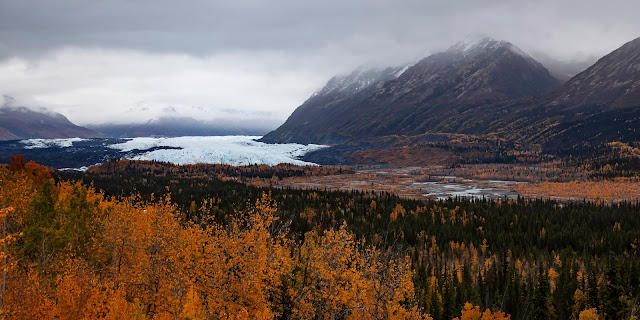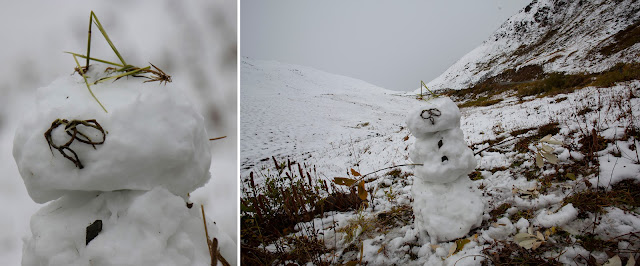 |
| Fall along the Glenn Highway |
Wildlife
On our way up, we stopped briefly at the Alaska Wildlife Conservation Center, a 200-acre zoo/rehab/research/education center in Girdwood on the shores of Turnagain Arm.
The Center, which opened to the public in 1993, has certainly grown since our first visit when there were only a few animals in fenced areas.
Now, the animals are located in different areas grouped around several road loops that you can walk or drive.
 |
| This sign cracks me up |
Most of the residents are rescues that cannot be released into the wild. This includes Black …
 |
| This guy was entertaining |
… and Brown Bears …
 |
| The Bears' enclosures are large and very natural |
… as well as Moose (which we could never find), Wood Bison, Reindeer, Elk, Wolves, Deer, Muskox and Foxes.
 |
| AWCC map |
It was a pleasant stop and we also got a couple of “Rudys” (Reindeer hotdogs) at the food truck on the grounds. It seemed rude to eat them in view of the Reindeer enclosure. But …
Our plan to go to Wasilla turned out to be a good plan. During the week we had been in Alaska, fall had come into its own. And, along the Glenn Highway out of Wasilla, it was spectacular.
First, we drove along the very colorful highway to the Matanuska Glacier.
 |
| The mighty Matanuska Glacier from an overlook |
We ended up not going to the foot of the glacier (which has shrunk considerably since first we saw it back in 2001). But, we did photograph it from the highway.
 |
| We've walked on it before, but it looks like access may have become more difficult |
At 27 miles long by 4 miles wide, the Matanuska Glacier is the largest glacier accessible by car in the United States. A valley glacier that moves about a foot a day, its terminus feeds the Matanuska River.
 |
| The foot of the glacier |
After that stop, we captured more fall foliage …
 |
| Color everywhere |
… and more incredible vistas …
 |
| Nice fall reflections |
… and more …
 |
| It looked pretty even on a gloomy day |
... gorgeous scenery ...
 |
| Lots of reflections |
Follow along here.
Then, we headed to the Little Susitna River, which originates in Hatcher Pass (where we were headed next) and then flows a few dozen miles to the Cook Inlet. Where we stopped, it flowed over boulders. It ranges from flat water near the inlet to class 5 water at the Pass Hatcher Pass. The "Little Su" flooded in 1972, 2006 and 2012.
 |
| A peaceful stop |
The River is fed by the Mint Glacier, Archangel Creek, Fishhook Creek, Government Creek, Nurse Creek, Mary Creek, Swiftwater Creek and numerous other unnamed streams.
 |
| The Mint Glacier, summer 2001 |
 |
| A beautiful river flowing over boulders |
And, then we headed on to Hatcher Pass …
 |
| Our destinations |
 |
| Fall meets winter at elevation |
At 3,886 feet, Hatcher Pass divides the alpine headwaters of Willow Creek on the west from the Independence Bowl and Fishhook Creek on the east. The heavily glaciated area has steep-walled cirques, jagged aretes and hanging valleys above U-shaped valleys.
 |
| Fall foliage |
Trees grow only in the lowest valley bottoms.
Brush, often dense, grows on lower mountain slopes, yielding to open tundra as elevation increase.
Some nearby peaks are over 6,000 feet tall.
The Castle Mountain Fault crosses the road a few miles south of Hatcher Pass. Studies show that magnitude 7 earthquakes can be expected to occur on this fault with approximately a 700-year recurrence interval. The last big earthquake was 650 years ago.
 |
| Hatcher Pass; Photo: Scott Stevens |
 |
| The road would be closing soon |
The area is popular for day trip recreation: sledding, skiing, snowmobiling, hiking, camping, hunting, white-water kayaking, berry-picking, climbing, recreational gold-mining, mountain biking and so forth.
 |
| Building snowmen is another recreational activity |
Independence Mine State Historic Park, a few miles east of the pass, consists of 271 acres of well-preserved mine buildings and a mining museum that offers underground mine tours. This mining district is historically the third-largest lode-gold producing district in Alaska, having produced 624,000 ounces of gold.
 |
| Photo: Mat-Su Convention & Visitors Bureau |
 |
| Totem poles dot the property |
Anchorage
After all this fall color and winter snow, we descended back into Anchorage, which was still fairly green.
We stopped at the Alaska Native Heritage Center, one of Scott’s favorite Anchorage spots.
This indoor/outdoor museum is an educational and cultural institution that shares the heritage of Alaska's 11 major cultural groups: Athabaskan people, Eyak people, Tlingit people, Haida people, Tsimshian people, Unangax people (Aleut), Alutiiq people, Yup'ik, Cup'ik, Siberian Yupik and Inupiaq.
 |
| The Eyak,Tsimshian, Tlingit, Haida Long House |
We stayed long enough for a walk-through ...
 |
| The Athabascan Village site on Lake Tiulana |
... and time to enjoy some dancing and sports demonstrations before we had to head to the airport.
 |
| Local young people from multiple native groups put on the presentations |
Bye
It wasn’t our best Alaska trip, but it was fun.







No comments:
Post a Comment